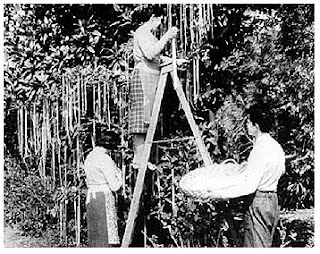 |
| An Evil Eye Tree - native to Cappadocia, Nevsehir, Turkey |
Ah, Spring! – a time for love, bountiful blossom displays and,inevitably, April Fools’ Day. This quasi-holiday
has traditional roots in Old World Europe but is now celebrated in
places as far-flung as India and Brazil. Although the exact reason for pranking on April 1st have been blurred by history, many possible origin stories point to celebrations of the Vernal Equinox and end-of-winter festivities as far back as the Celts and Romans. Spring planting traditions come into play at this time of year and many people believe that April Fools’ Day speaks to the
foolishness of planting in the unpredictable weather of early spring.
 |
| Which ones are the Lichops? |
A surprising number of pranks and hoaxes have grown out of the gardening and botanical worlds over the years. Perhaps, in part, because there are many plants who are tricksters in their own right. Take the
Lithops, for example: Also known as “Living Stones”, these southern African succulents have evolved to look like just another rock in the ground (a “no need to look here” for any herbivore searching for lunch). Then there are the
Fooled You Peppers: These fascinating little green gems have the look and flavor of jalapeños without any of the heat. This is a wonderful thing for people like me who cannot handle the heat. I also think there is a juicy prank in here somewhere (like: I’ll bet you I can eat 15 of these jalapeños without stopping” kind of thing).
Here is an article from the Smithsonian with more interesting prankster plants and
here is a link to my blog from last October about strange plants (who are also mostly fakers).
 |
| 1957 Spaghetti Harvest in Ticino, Switzerland |
As I mentioned before, plants and gardening seem to find their way into April Fools’ pranks quite a bit. One famous example is the
1957 BBC presentation of “Spaghetti - Harvest in Ticino”. In this bit, their news program,
Panorama, “reported” on the bumper crop of spaghetti that grew from spaghetti trees due to mild spring weather. A well-known war correspondent narrated the piece with the utmost gravitas, giving it extra credibility. Many people were fooled, of course, and some even tried to book holidays to go see the crop for themselves. This is a perfect example of how something that is clearly absurd can be said with enough sincerity that people will believe it.
 |
| Beautiful Maple Trees |
In 2005, another legitimate news source, NPR (National Public Radio) perpetrated its own tree-related hoax. As heard on their program
All Things Considered, they claimed that Maple trees in New England were exploding and causing serious injuries and even death. According to this fanciful report, the trees were exploding due to a decrease in maple sugar consumption, which meant that the trees were not being tapped and had built up sugar pressure. Apparently, this this hoax has stuck around;
here is an article where they are still trying to debunk the myth in 2015.
Hear the NPR program here.
It seems like people these days are willing to believe anything can be hybridized; go on the internet and you can find hundreds, if not thousands, of stories of
fantastical hybridized living things. While there
are amazing hybrids, the
pinana is not one of them. This banana-pineapple hybrid was the 2009 April Fools prank of the British supermarket chain Waitrose. Although it’s not a real fruit hybrid, I think they should get on this and create it for real – it sounds delicious.
Google has even got into the garden hoax business with their 2017 “announcement” of a smart device for your yard – the Google Garden Gnome.
The video is really funny – it
almost makes me wish this were real.

I have not participated in any April Fools’ pranks since my brother and I decided it was a good idea to interchange the sugar and salt on our kitchen table. Soon after our father sat down for his morning coffee we discovered that it was a really bad idea. That said, after all these years I am willing to present my own botanical hoax, albeit in a halfhearted way - I am going to see if anyone wants to bite on the Evil Eye Tree that I posted at the top of this blog. Would there be someone out there who believes that it really grows evil eye amulets?
If you are an unrepentant prank-puller,
here are some ideas for you. I hope that you can find something fun and new to do, but do so cautiously - not everyone will think they are as funny as you do!
Submitted by Pam




 I have not participated in any April Fools’ pranks since my brother and I decided it was a good idea to interchange the sugar and salt on our kitchen table. Soon after our father sat down for his morning coffee we discovered that it was a really bad idea. That said, after all these years I am willing to present my own botanical hoax, albeit in a halfhearted way - I am going to see if anyone wants to bite on the Evil Eye Tree that I posted at the top of this blog. Would there be someone out there who believes that it really grows evil eye amulets?
I have not participated in any April Fools’ pranks since my brother and I decided it was a good idea to interchange the sugar and salt on our kitchen table. Soon after our father sat down for his morning coffee we discovered that it was a really bad idea. That said, after all these years I am willing to present my own botanical hoax, albeit in a halfhearted way - I am going to see if anyone wants to bite on the Evil Eye Tree that I posted at the top of this blog. Would there be someone out there who believes that it really grows evil eye amulets?































